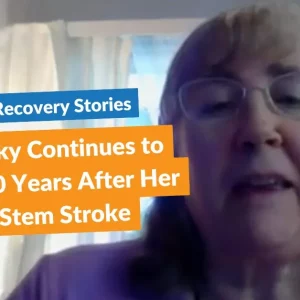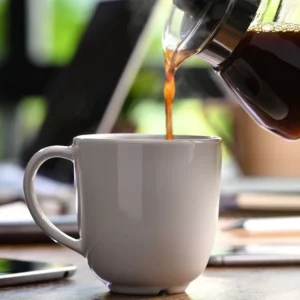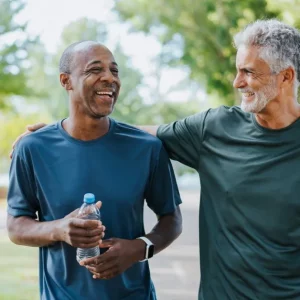Over half of all stroke survivors experience cognitive changes within a year of their stroke, making cognitive recovery after stroke an essential component of the rehabilitation process. Individuals experiencing post-stroke cognitive impairment may have trouble with memory, organization, attention and other cognitive skills.
Focusing on cognitive recovery after stroke can help survivors restore cognitive skills and improve their quality of life. This article will describe the potential effects of post-stroke cognitive impairment and outline what pursuing cognitive recovery after stroke may entail. Please use the links below to jump directly to any section of this article.
- What is a post-stroke cognitive impairment?
- Importance of pursuing cognitive recovery after stroke
- Achieving cognitive recovery after stroke
- Learning to manage cognitive changes
What is a Post-Stroke Cognitive Impairment?
When a stroke compromises the blood supply in the brain, survivors may experience a number of physical and cognitive changes depending on the area of the brain affected. While the physical effects of stroke may be more readily apparent, cognitive changes may also significantly affect a survivor’s daily life.
According to the American Heart Association, approximately 60% of stroke survivors experience cognitive changes in the first year after their stroke. Every stroke is unique, and therefore the specific cognitive changes that each survivor experiences vary widely and range in intensity from mild to severe. Regardless of the specific cause or severity, any cognitive impairment noted after a stroke is considered a post-stroke cognitive impairment.
Some of the most common functions that may be affected among those with post-stroke cognitive impairment include:
- Memory: forming new memories and retrieving previously stored information
- Attention: focusing the senses on a specific target, while tuning out other information
- Language: cognitive components of language include the processes of comprehension and mentally formulating language
- Perceptual-motor skills: the combination of sensory and motor skills required to interact with one’s surroundings, such as hand-eye coordination, body awareness, and spatial relations
- Executive function: high-level cognitive skills required to modulate one’s behavior, such as planning and organizational skills, working memory, judgment, and impulse control
Post-stroke cognitive impairment is most likely following damage to the left frontotemporal lobes, the left thalamus, and the right parietal lobe. This is because these areas of the brain are highly involved in cognitive functions.
It is important for survivors and their loved ones to understand post-stroke cognitive impairment and be aware of its prevalence in order to promptly address it. Not all cognitive changes occur immediately after stroke, so it is essential to talk with the survivor’s medical team regarding any potential changes in cognition. While it is possible to continue recovering even years after stroke, pursuing rehabilitation early on can promote an optimal cognitive recovery after stroke.
Importance of Pursuing Cognitive Recovery After Stroke
In addition to affecting cognitive functions, post-stroke cognitive impairment can impact survivors’ independence with daily activities and their ability to return to work. Furthermore, survivors often report psychological changes such as depression, as well as a diminished quality of life.
With the appropriate rehabilitation methods, many stroke survivors can progress toward cognitive recovery after stroke. While approximately 1 in 5 survivors with mild post-stroke cognitive impairment achieve a full recovery, many others make significant gains.
There are a number of ways to optimize cognitive recovery after stroke, including using early cognitive screening to identify potential cognitive impairments and actively participating in cognitive rehabilitation as soon as possible. Early detection and rehabilitation for post-stroke cognitive impairment are ideal to achieve an optimal recovery.
This is because during the first few months following a stroke, the brain enters a heightened state of neuroplasticity. Through neuroplasticity, the brain has the ability to adaptively rewire itself, transferring control of affected functions to healthy areas of the brain. This allows functions that were previously lost or impaired to be restored.
Neuroplasticity is activated through repetitive practice. When a task is performed over and over, the brain perceives a demand for the functions associated with that task, and subsequently creates and strengthens the related neural pathways. Although neuroplasticity may be activated at any point of recovery, taking advantage of enhanced neuroplasticity in the initial stages of recovery can boost cognitive recovery after stroke.
Achieving Cognitive Recovery After Stroke
There are a number of pharmacological and nonpharmacological strategies to work toward achieving cognitive recovery after stroke. Depending on the individual’s needs, doctors may recommend a combination of the following treatments:
1. Cognitive Rehabilitation
Cognitive rehabilitation focuses on repetitively practicing tasks to enhance cognitive functions. Frequent practice of cognitive exercises and activities activates neuroplasticity, allowing the brain to recover through adaptive rewiring.
Cognitive rehabilitation strategies vary depending on which functions have been affected. For example, interventions may include memory games, visual scanning practice, music-based therapies, or functional activity simulations. These interventions are often carried out by a speech language pathologist, occupational therapist or psychologist.
2. Physical Exercise
In addition to practicing cognitive rehabilitation exercises, physical exercise may boost cognitive recovery after stroke. Numerous studies have found that exercise, particularly aerobic exercise, can play a role in improving cognitive performance. In fact, participation in an aerobic exercise program is recommended for most stroke survivors due to its many benefits.
Physical exercise improves physiological processes within the brain. For example, exercise increases the production of brain-derived neurotropic factor (BDNF), a growth factor that promotes neuroplasticity, which is essential for stroke recovery.
Furthermore, exercise can improve depression and other secondary complications of stroke that often occur in those with post-stroke cognitive impairment. Although physical exercise alone can improve cognition, it is most effective to combine exercise with cognitive rehabilitation.
3. Cognitive Rehabilitation Technology
Since consistent, repetitive practice is essential to activate neuroplasticity, it is important that stroke survivors continue to practice therapeutic tasks even outside of therapy sessions. Many digital therapeutic tools and computer-assisted cognitive rehabilitation devices for home use have been developed specifically to promote cognitive recovery after stroke.
Various technologies, including online treatment programs, phone applications, virtual reality interventions, computer-based software, and video games, have been used to create programs that supplement conventional cognitive rehabilitation. The gamified approach to rehabilitation provided by these technologies can be very motivating. Furthermore, these programs can often adapt to an individual’s skill level to provide appropriately challenging tasks.
One example of a phone app focused on cognitive rehabilitation is the CT Speech and Cognitive Therapy app. This app was designed by speech therapists to include beginner to advanced-level exercises targeting a variety of cognitive skills, including attention, memory, and reasoning. Talking with a therapist may help survivors discover which technological cognitive rehabilitation program may be most beneficial.
Want to learn more about the CT Speech and Cognitive Therapy App? Get Started Here.
(Link opens a pop-up for uninterrupted reading.)
4. Pharmacological Strategies
Pharmacological treatments for post-stroke cognitive impairment are continuing to be studied. However, taking blood-pressure lowering medications can improve cognitive outcomes, as managing hypertension has been shown to minimize cognitive decline. Cognitive stimulants may also be prescribed to boost cognitive recovery after stroke.
There are a number of other types of medications that have been considered to improve cognition after stroke, including cholinesterase inhibitors (like donepezil, rivastigmine, and galantamine) and the N-methyl-D-aspartate (NMDA) receptor antagonist memantine. However, these have been primarily studied among those with vascular dementia, rather than less severe post-stroke cognitive impairments.
Other potential pharmacological options that may be beneficial to promote cognitive recovery include citicoline, nimodipine, Ginkgo biloba, and long-chain omega-3 polyunsaturated fatty acids (O-3-FAs). However, more research is needed to determine the effectiveness of these medications and supplements. For more personalized information, survivors should talk with their doctors regarding the benefits of pharmacological treatments for cognitive recovery after stroke.
5. Emerging Treatments
New treatments to improve cognitive recovery after stroke are consistently being examined among researchers. Emerging treatment options include:
- Growth hormone therapy: Growth hormones have been shown to promote the formation of new neurons (brain cells) and blood vessels. With these benefits in mind, studies have demonstrated that growth hormone therapy may improve cognitive outcomes after stroke.
- Non-invasive brain stimulation: The use of non-invasive brain stimulation may promote many cognitive functions after stroke, particularly attention and working memory.
- Acupuncture: The use of Traditional Chinese medicine, including acupuncture, has been shown to potentially boost cognitive recovery after stroke.
While more evidence is needed to determine their effectiveness, these emerging treatments may be worth considering and discussing with one’s medical team. Since there is no “one size fits all” treatment for cognitive recovery after stroke, using a combination of the rehabilitative strategies above tends to yield the best results.
Managing Cognitive Changes After Stroke
Although addressing the underlying cause of post-stroke cognitive impairment through rehabilitative treatments is considered ideal, there are a number of techniques that individuals use to complete daily tasks despite cognitive changes. These strategies, referred to as compensatory techniques, allow individuals to manage their cognitive deficits in order to maximize their independence and quality of life.
Depending on which cognitive functions have been affected, the best compensatory strategies may vary. However, here are some of the most commonly recommended compensation techniques:
- Use reminders. This may include noting important tasks and appointments on a calendar or in a planner, strategically placing sticky notes to jog one’s memory, and setting alarms to remember specific activities.
- Minimize distractions. Reducing excess noise and clutter can be particularly helpful for individuals who struggle with attention.
- Write in a notebook. Using a journal or notebook can help individuals remember day-to-day events and conversations. Additionally, writing down one’s thoughts can aid in decision making and mental organization.
Although compensatory techniques can serve as a great stepping stone, they can also impede cognitive recovery. This is because using these techniques reduces the need to exercise targeted cognitive skills. For example, always working in a silent area free of distractions does not allow individuals to practice filtering out excess stimulation to improve their attention. Therefore, as individuals progress toward cognitive recovery, it is important to try to wean off of using compensatory strategies.
Understanding Cognitive Recovery After Stroke
Post-stroke cognitive impairment is a relatively common secondary effect of stroke. Changes in cognition can affect the ability to participate in daily activities and may reduce survivors’ quality of life.
There are a number of treatment options to promote cognitive recovery after stroke, including practicing cognitive rehabilitation exercises, participating in regular physical exercise, and using pharmacological treatments. These treatments can promote neuroplasticity, or the brain’s ability to rewire itself.
Although remediating cognitive functions is ideal, individuals may also utilize compensatory strategies to promote independence despite changes in cognition. While not all individuals achieve a full cognitive recovery after stroke, there is always hope for recovery through neuroplasticity.









